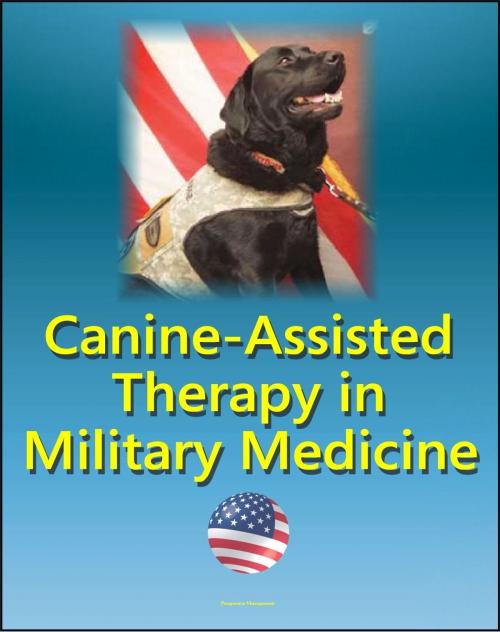Canine-Assisted Therapy in Military Medicine: Dogs and Human Mental Health, Wounded Warriors, Occupational Therapy, Combat Veterans, History of Army Dogs, PTSD, Nonmilitary Settings, Stress Control
Nonfiction, Health & Well Being, Medical, Specialties, Occupational & Industrial Medicine, Allied Health Services, Occupational Therapy| Author: | Progressive Management | ISBN: | 9781476034539 |
| Publisher: | Progressive Management | Publication: | May 3, 2012 |
| Imprint: | Smashwords Edition | Language: | English |
| Author: | Progressive Management |
| ISBN: | 9781476034539 |
| Publisher: | Progressive Management |
| Publication: | May 3, 2012 |
| Imprint: | Smashwords Edition |
| Language: | English |
This important military document, professionally formatted for easy flowing-text reading, focuses on the expanding role of dogs in the military healthcare system. Sixteen chapters explore the recognition and acceptance of the value of therapy dogs by both military and civilian healthcare professionals. The articles examine the various capacities in which dogs work among patients in medical facilities. There are also detailed discussions of the fairly recent initiative of deploying specially trained dogs overseas with combat and operational stress control teams to assist in their vitally important work in the mitigation of stress and anxiety among deployed personnel. Interestingly, as described in one article, this role of canine therapy has been applied repeatedly to disasters and tragic events in the United States, beginning with September 11, 2001, to address the confusion, stress, and anxiety of both victims and rescue/recovery workers in dealing with the feelings of futility, frustration, and loss. Many readers who have pets or other involvement with animals in their lives will probably not be particularly surprised at the descriptions of human reactions to the presence of the dogs depicted in these articles. However, all readers should find the extent of the situations and conditions to which dogs are successfully lending assistance to be intriguing, and perhaps a bit surprising. Although attempts to systematically quantify and scientifically evaluate the results of animal-assisted therapy have been and will continue to be made, for now the anecdotal evidence of its overwhelmingly positive impact is not only encouraging, but also substantial enough to support its continuation.
Contents: 1 - Perspectives * 2 - The Early Years * 3 - Policy Initiatives for the Use of Canines in Army Medicine * 4 - Definitions of Animals Used in Healthcare Settings * 5 - Historical Perspectives of the Human-Animal Bond Within the Department of Defense * 6 - Dogs and Human Health/Mental Health: From the Pleasure of Their Company To the Benefits of Their Assistance * 7 - Research on Benefits of Canine-Assisted Therapy for Adults in Nonmilitary Settings * 8 - The Effects of Animal-Assisted Therapy on Wounded Warriors in an Occupational Therapy Life Skills Program * 9 - Training the Combat and Operational Stress Control Dog: An Innovative Modality for Behavioral Health * 10 - Occupational Therapists as Dog Handlers: The Collective Experience with Animal-Assisted Therapy in Iraq * 11 - Crossing the Berm: An Occupational Therapist's Perspective on Animal-Assisted Therapy in a Deployed Environment * 12 - Rehabilitative Canine Interactions at the Walter Reed National Military Medical Center * 13 - Canines for Combat Veterans: The National Education for Assistance Dog Services * 14 - Service Dog Training Program for Treatment of Posttraumatic Stress in Service Members * 15 - Reclaiming Identity Through Service to Dogs in Need * 16 - Therapy Dogs and Stress Management Assistance During Disasters.
Humans have domesticated animals for assistance and companionship since before the beginning of recorded history. Beasts of burden permitted the development of civilization by breaking land for agriculture with plows, and carrying crops, products, and people in larger quantities and over longer distances than human backs and feet could ever achieve. The longest recognized domesticated animal, the canine, provided humans with assistance in hunting and security, as well as companionship, throughout history, and continues to serve in those and other capacities today.
Everyone is, of course, familiar with the "police dog," a fixture of law enforcement agencies for most of the last century. Police have also used dogs for tracking offenders and finding victims and lost individuals for many decades. Less well-known, but with a legacy of use that precedes that of law enforcement, is the military working dog.
This important military document, professionally formatted for easy flowing-text reading, focuses on the expanding role of dogs in the military healthcare system. Sixteen chapters explore the recognition and acceptance of the value of therapy dogs by both military and civilian healthcare professionals. The articles examine the various capacities in which dogs work among patients in medical facilities. There are also detailed discussions of the fairly recent initiative of deploying specially trained dogs overseas with combat and operational stress control teams to assist in their vitally important work in the mitigation of stress and anxiety among deployed personnel. Interestingly, as described in one article, this role of canine therapy has been applied repeatedly to disasters and tragic events in the United States, beginning with September 11, 2001, to address the confusion, stress, and anxiety of both victims and rescue/recovery workers in dealing with the feelings of futility, frustration, and loss. Many readers who have pets or other involvement with animals in their lives will probably not be particularly surprised at the descriptions of human reactions to the presence of the dogs depicted in these articles. However, all readers should find the extent of the situations and conditions to which dogs are successfully lending assistance to be intriguing, and perhaps a bit surprising. Although attempts to systematically quantify and scientifically evaluate the results of animal-assisted therapy have been and will continue to be made, for now the anecdotal evidence of its overwhelmingly positive impact is not only encouraging, but also substantial enough to support its continuation.
Contents: 1 - Perspectives * 2 - The Early Years * 3 - Policy Initiatives for the Use of Canines in Army Medicine * 4 - Definitions of Animals Used in Healthcare Settings * 5 - Historical Perspectives of the Human-Animal Bond Within the Department of Defense * 6 - Dogs and Human Health/Mental Health: From the Pleasure of Their Company To the Benefits of Their Assistance * 7 - Research on Benefits of Canine-Assisted Therapy for Adults in Nonmilitary Settings * 8 - The Effects of Animal-Assisted Therapy on Wounded Warriors in an Occupational Therapy Life Skills Program * 9 - Training the Combat and Operational Stress Control Dog: An Innovative Modality for Behavioral Health * 10 - Occupational Therapists as Dog Handlers: The Collective Experience with Animal-Assisted Therapy in Iraq * 11 - Crossing the Berm: An Occupational Therapist's Perspective on Animal-Assisted Therapy in a Deployed Environment * 12 - Rehabilitative Canine Interactions at the Walter Reed National Military Medical Center * 13 - Canines for Combat Veterans: The National Education for Assistance Dog Services * 14 - Service Dog Training Program for Treatment of Posttraumatic Stress in Service Members * 15 - Reclaiming Identity Through Service to Dogs in Need * 16 - Therapy Dogs and Stress Management Assistance During Disasters.
Humans have domesticated animals for assistance and companionship since before the beginning of recorded history. Beasts of burden permitted the development of civilization by breaking land for agriculture with plows, and carrying crops, products, and people in larger quantities and over longer distances than human backs and feet could ever achieve. The longest recognized domesticated animal, the canine, provided humans with assistance in hunting and security, as well as companionship, throughout history, and continues to serve in those and other capacities today.
Everyone is, of course, familiar with the "police dog," a fixture of law enforcement agencies for most of the last century. Police have also used dogs for tracking offenders and finding victims and lost individuals for many decades. Less well-known, but with a legacy of use that precedes that of law enforcement, is the military working dog.















